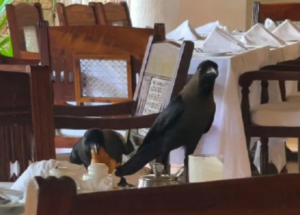For many living along Kenya’s coast, the term “invasive alien birds” is all too true, even though it sounds like a plot device from a Hollywood thriller. The Indian house crows are causing a great deal of trouble in Kenya. Therefore, the government has decided to kill one million of them. In this scenario, unlike in Alfred Hitchcock’s horror film “The Birds,” the antagonists are non-human creatures that have disrupted society for many years by assaulting chicken farms, tourist hotspots, and animals.
The Indian House Crow: A Potential Danger
Poison is being used to kill off the initial group of these hostile birds in Watamu and Malindi. The ambitious campaign’s goal is to stop them from reaching Nairobi, the capital. Crows like this, which the locals call “kunguru” or “kurabu,” came to the Americas from Asia and other regions, frequently hopping on commerce ships. Their alleged 1890s introduction to the then-British territory of the Zanzibar archipelago was an attempt to solve the island nation’s mounting garbage problem. After that, they made their way to the continent and eventually arrived in Kenya along the seashore.
A House Crow’s Ascent in India
In 1947, the port of Mombasa was the first place where the meat-eating Indian house crows were documented. Since then, their numbers have skyrocketed, thanks to human population growth and the garbage it produces, which creates an excellent habitat for them to thrive in. Being one of the most invasive and harmful bird species in the world, their numbers have continued to expand due to the lack of natural predators.
Crows like these have a terrible effect on biodiversity, says Dutch bird expert Jaap Gijsbertsen, who was in Watamu to study the local avian, mammalian, and reptilian fauna. Crows are killing off native tiny birds like weavers and waxbills by destroying their nests and eating their eggs and young. There are far-reaching environmental effects of declining local bird populations, such as an upsurge in dangerous insects and pests that these birds formerly controlled.
Effects on Neighboring Populations and Animals
Crows may wreak havoc on chickens, crops, and cattle. Crows pounce on chicks and devour them ferociously; Eunice Katana, a native of Takaye village in Kilifi county, describes the behavior. In addition to being a nuisance, the birds’ distinctive calls indicate danger and lure potential predators.
People in Mombasa stay away from sitting under tree shades because crows have soiled dwellings with their droppings. They add to the ever-expanding list of complaints by waking up the locals at the crack of dawn. The birds’ constant cacophony has irritated Mombasa resident Victor Kimuli.

Efforts to Reduce Culling
In light of these concerns, the government has chosen to take action, with the goal of poisoning half of India’s house crow population. The Kenya Wildlife Service (KWS) reports that this program is the result of months of meetings with several stakeholders, including community leaders, environmentalists, and hotel sector representatives. Months of pre-baiting, in which crows congregate at designated locations, is required for the culling process. Starlicide is an effective avian poison that has been used to poison a large flock of birds without injuring other birds or animals.
Little Kenya Gardens, the authorized importer of Starlicide, killed approximately 2,000 crows in 2022 while testing the poison’s effectiveness. The proprietor of the enterprise, Cecilia Ruto, says that the crow metabolizes the slow-acting poison completely before it dies, which lowers the chance of secondary poisoning to other animals that could eat the dead birds. Plans are being made to import further quantities from New Zealand; the current stockpile is 2 kilograms (4.4 pounds), which is enough to kill an estimated 20,000 crows.
Problems with Ethics and Possible Solutions
But animal and bird rights campaigners have voiced ethical issues about poisoning, saying it’s cruel and calling for alternatives to killing. Mass poisoning is just a band-aid solution that won’t get to the bottom of the crow problem, according to environmentalist Leonard Onyango, who stresses the importance of humane, sustainable methods to control the crow population.
In spite of these reservations, culling program proponents insist that native species protection and ecological harmony must take precedence. As the initiative’s central protagonist, Kirao, points out, the damage could become permanent if nothing is done. Government efforts to manage invasive bird species have been attempted before; a prior effort, which was successful in reducing the bird population over 20 years ago, has been hindered by later limitations on Starlicide imports.
Problems That Hotels and Tourist Destinations Face
The crows have made tourist hotels their favorite haunt, frequently appearing in the dining areas to squawk and generally ruin people’s mealtimes. The crows have become a major annoyance to visitors, according to Maureen Awuor, chairperson of the Kenya Association of Hotelkeepers and Caterers. A few hotels have taken to smothering the birds in traps, while others have hired people to use catapults to drive the birds away. But these tactics seldom work because the smart birds learn to avoid places where they see other birds caught or killed.
How Critical the Situation Is
The officials are hell-bent on keeping the extermination effort going, particularly because they’re worried the crows may go even farther inland. Mtito Andei, located approximately 240 kilometers (150 miles) from Nairobi, is where conservationists have seen the birds. If the crows make it to Nairobi, Kirao is quite worried that they will decimate the local bird population, especially in Nairobi National Park.
The continuous struggle in coastal Kenya against the invading Indian housecrows highlights the intricate difficulties of controlling invasive species while juggling ethical concerns and environmental protection. The survival of native species and the state of the environment in the area will depend on the results of this massive culling effort.



















